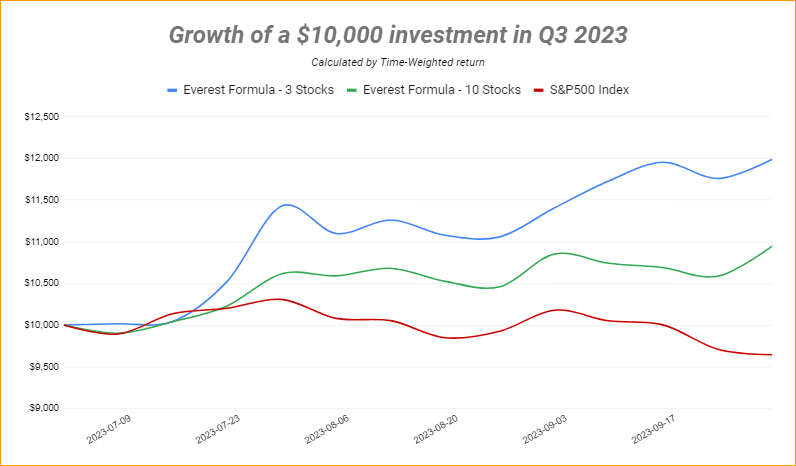- After solid gains for shares in the first half of 2023, global equities posted a negative return in Q3. An overall rising bond yield mainly caused this, and investors have realized that the optimism that drove the first-half rally was misplaced, particularly expectations that the Federal Reserve would soon be pivoting to lowering rates.
- In this article, we will see how the Everest Formula has performed in comparison with the U.S. indices, also looking at the outlook for the following months.
A review of the last three months
Heading into the final months of 2023, the bullish sentiment that lifted stocks out of a bear market has faded. Some of the optimism that drove the first-half rally was misplaced, particularly expectations that the Federal Reserve would soon be pivoting to lowering rates.
Investors grew cautious as the reality of ‘higher for longer’ interest rates became apparent. Bond yields rose throughout the quarter, with U.S. 10-year yields hitting a 16-year high on the first day of the fourth quarter.
Investors entered the third quarter optimistic that the Federal Reserve (Fed) had orchestrated a soft landing for the economy, and that the era of policy tightening rates would soon end. However, that enthusiasm withered over August and September as the prospect of a sustained period of higher rates sank in. Investors continue to wonder whether the Fed will deliver a “soft landing” or a slowing of the economy/inflation without creating a recession, a spike in unemployment or a decline in asset prices.
That question is growing more intense as some economic cracks are starting to appear. New home sales are softening, with August’s total down 8.7% from July. The Conference Board’s consumer confidence gauge fell to 103 in September, down from 108.7 in August. Since July 31, the widely watched 10-year U.S. Treasury yield has risen from 3.96% to 4.57%, a sharp move that increases borrowing costs on items like mortgages and cars.
These are the reasons why it is unsurprising that the S&P 500 index reached -3.6% in Q3, consolidating after a solid start to 2023, bringing its year-to-date gains to +11.8%. The Nasdaq even realized a negative performance of -4.1%. Most of the seven most important stocks of the S&P500 – Apple, Microsoft, Alphabet, Amazon, Tesla, Nvidia and Meta – declined, weighing on the overall market. The I.T. sector overall was one of the weakest areas over the quarter, along with the less influential sectors of real estate and utilities.

How has Everest Formula performed in this environment? Once again, the results were surprising: the 3-stock strategy closed on September 30 with a consistent gain of +19.9%, while the 10-stock strategy gained a more limited +9.5%, but with less volatility.

So far, the 3-stock strategy has recorded a gain of +39.7% in 2023, while the 10-stock strategy has registered a +16.7%. An important factor that led to these results can be considered the presence of some energy stocks in the top positions of the rankings. Energy stocks were relatively resilient over the quarter, and one of few bright spots in a quarter where few sectors avoided falls.
Therefore, the Everest Formula beat the market consistently in this uncertain period, having a strong positive performance even if the markets shifted to the red sign. Despite this, we must outline that the volatility was higher than the S&P500. As we highlighted many times, any strategy that uses only a few stocks (like the Everest Formula) has a remarkable volatility that can worry less risk-tolerant investors. For this reason, we suggest applying our strategy to the risky part of your portfolio, which aims towards greater profits.
What is the outlook for the coming months?
Consumer spending has defied expectations and helped some economies avoid a recession so far. In the U.S., spending has continued to rise, though August’s data was slightly weaker than expected. Anyway, several headwinds could begin to impact spending:
- Rates on credit card debt, mortgages and home loans are now very high, and it doesn’t look like there will be relief any time soon.
- At the same time, savings accumulated during the pandemic have been depleted.
- In the U.S., the pause on student loan repayments ended last week and will now cost consumers another $8 billion monthly.
A slowdown in consumer spending would majorly affect economic growth and sentiment, not just consumer-facing sectors.
What about the Everest Formula? Many investors in the past have asked us how the Everest Formula will perform in the event of a recession or market crash. Although past performance is no guarantee for the future, backtests show that in the last 24 years, during negative periods for the stock market (e.g., 2000, 2008, 2020, 2022), the Everest Formula initially followed the negative market trend but then rebounded faster, as it did in 2023. So, even if a recession in 2024 is plausible, the Everest Formula can achieve good results in the foreseeable future.
We don’t know whether the Everest Formula will continue to beat the market month after month, but we firmly believe that selecting good companies at a bargain price will always be a good investment strategy.
If you want to find the best profitable and undervalued stocks in the market, join us now.

